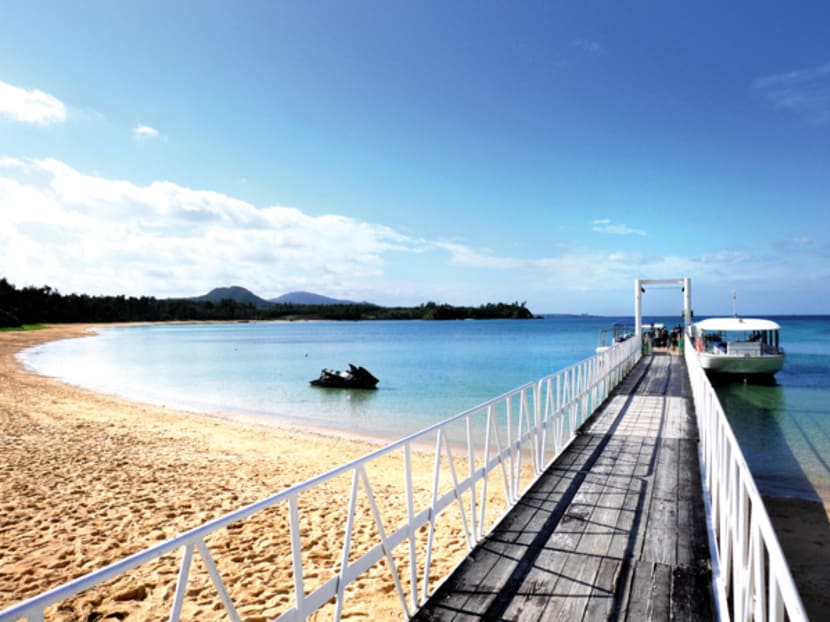Better than OK
Okinawa is pretty much paradise. With gorgeous weather, magnificent scenery and activities for travellers of all ages, it is particularly great for intergenerational groups going on vacation together.

Kariyushi Beach in Okinawa. PHOTO: Maureen Yeo
Okinawa is pretty much paradise. With gorgeous weather, magnificent scenery and activities for travellers of all ages, it is particularly great for intergenerational groups going on vacation together.
OCEAN LIFE
At Kariyushi Beach, zip up your jet-skiing boots and you may find yourself flying over the surface of the sea. For those less nautically-inclined, a glass-bottomed boat lets you see a variety of marine life, including large schools of pufferfish.
If you scuba dive, head out to the remote islands and reefs for sightings of hammerhead sharks passing through Yonaguni from November to June, graceful manta rays at Ishigaki Island, and larger fishes such as the giant trevally and the dogtooth tuna at Tonbara Rock.
SHIMMERING SIGHTS
Not far from Kariyushi Beach is Cape Manzamo. Manzamo means grassland where 10,000 men can sit. That’s fairly descriptive but the reality is even more dramatic — cliffs with multiple shades of blue stretching out to the shimmering East China Sea.
Other sights include several castles from the Ryukyu period that preceded Japan’s colonisation of Okinawa. For much of its existence, Okinawa was a separate political entity from Japan, with its own feuding warlords who each tried to gain supremacy over the Ryukyu kingdom. Ruined fortresses are what remain of these warlords’ legacies.
A classic is the Nakijin Castle that took more than 100 years to build. Three generations of rulers dwelt there until 1609 when the Japanese feudal domain of Satsuma invaded Okinawa and razed the castle to the ground. While all that remain are the extensive walls crisscrossing the sprawling complex, the hilly grounds caressed by sea breezes make for a pleasant stroll.
TRADITIONAL CRAFTS
At Yomitan Pottery Village, numerous ceramics studios founded by state-lauded masters are situated along a wooded cul-de-sac. Here, you can watch their descendants create plates, cups, bowls and sake bottles decorated with Okinawan motifs like fish and flowers.
Watch the sculptors create shisa, decorative figures that look like a cross between a lion and a dog. These are often found in pairs outside buildings and on rooftops. Shisa are evident of Okinawa’s exchanges with China during the Ryukyu period.
NOT THE USUAL KIMONO
In North Okinawa, bashofu kimonos are handed down from generation to generation and often given as part of wedding trousseaus.
Bashofu is a special textile made from banana fibres. A particular species of banana is cultivated to ensure the best fibres are produced.
When harvested, these fibres are softened by boiling in wood lye, stripped by hand, then painstakingly joined by fine knots to form a long thread that is dyed and woven into textile.
The intricate process takes months, which makes bashofu a highly prized textile.
Bashofu is only made in Okinawa’s Ogimi Village, which you can visit to see the skilful ladies at work.
Finally, you can learn some traditional Okinawan craft yourself. Shuri Ryusen conducts workshops on bingata, a method of resist dyeing using stencils that developed as a combination of Indian, Chinese, and Javanese dyeing techniques.
The results bear some resemblance to batik, mirroring Okinawa’s rich interactions with other cultures. How better to end your trip than to fleetingly become an Okinawan artisan and bring a piece of Okinawa home with you?
TRAVEL TIPS:
Getting there
SilkAir occasionally has chartered flights that go to Okinawa directly. Otherwise, airlines such as Singapore Airlines, Cathay Pacific, China Airlines and ANA fly to Okinawa with stops in Hong Kong, Taipei, Beijing or Tokyo.
Getting around
Rent a car from OTS and hit the scenic coastal roads. It is easy to navigate Okinawa; the only thing you have to be wary of is the drive time. Even short distances can take time to cover due to the speed limits of 40-50kmh and heavy traffic around Naha city.
When to go
From mid-January to February, the cherry blossoms are in bloom, and Nakijin Castle is particularly pretty at this time of the year. This period is also when humpback whales migrate through Okinawan waters. Whale-watching cruises operate until late-March. Most of the hotels’ outdoor pools and beaches are closed from November to end-March, so if you’re into swimming and other water sports, visit during the warmer months.





